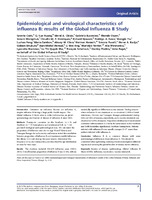Use este identificador para citar ou linkar para este item:
http://sgc.anlis.gob.ar/handle/123456789/1385| Título: | Epidemiological and virological characteristics of influenza B: results of the Global Influenza B Study | Autor(es): | Caini, Saverio Huang, Q Sue Ciblak, Meral A Kusznierz, Gabriela F. Owen, Rhonda Wangchuk, Sonam Henriques, Cláudio M P Njouom, Richard Fasce, Rodrigo A Yu, Hongjie Feng, Luzhao Zambon, Maria Clara, Alexey W Kosasih, Herman Puzelli, Simona Kadjo, Hervé A Emukule, Gideon O Heraud, Jean-Michel Ang, Li Wei Venter, Marietjie Mironenko, Alla Brammer, Lynnette Mai, Le Thi Quynh Schellevis, François Plotkin, Stanley Paget, John |
Palavras-chave: | Estudio Global de Influenza B (GIBS);Carga de enfermedad;Epidemiología;Gripe Humana;Vacunación;vaccine mismatch | Data do documento: | Ago-2015 | Jornal: | Influenza and other respiratory viruses | Resumo: | INTRODUCTION: Literature on influenza focuses on influenza A, despite influenza B having a large public health impact. The Global Influenza B Study aims to collect information on global epidemiology and burden of disease of influenza B since 2000. METHODS: Twenty-six countries in the Southern (n = 5) and Northern (n = 7) hemispheres and intertropical belt (n = 14) provided virological and epidemiological data. We calculated the proportion of influenza cases due to type B and Victoria and Yamagata lineages in each country and season; tested the correlation between proportion of influenza B and maximum weekly influenza-like illness (ILI) rate during the same season; determined the frequency of vaccine mismatches; and described the age distribution of cases by virus type. RESULTS: The database included 935 673 influenza cases (2000-2013). Overall median proportion of influenza B was 22·6%, with no statistically significant differences across seasons. During seasons where influenza B was dominant or co-circulated (>20% of total detections), Victoria and Yamagata lineages predominated during 64% and 36% of seasons, respectively, and a vaccine mismatch was observed in ≈25% of seasons. Proportion of influenza B was inversely correlated with maximum ILI rate in the same season in the Northern and (with borderline significance) Southern hemispheres. Patients infected with influenza B were usually younger (5-17 years) than patients infected with influenza A. CONCLUSION: Influenza B is a common disease with some epidemiological differences from influenza A. This should be considered when optimizing control/prevention strategies in different regions and reducing the global burden of disease due to influenza. |
URI: | http://sgc.anlis.gob.ar/handle/123456789/1385 | DOI: | 10.1111/irv.12319 |
| Aparece nas Coleções: | Publicaciones INER |
Arquivos neste item:
| Arquivo | Descrição | Tamanho | Formato | |
|---|---|---|---|---|
| irv0009-0003.pdf | Artículo en inglés | 315.29 kB | Adobe PDF |  Ver/Aberto |
Visualização de página
172
Checado em 30/12/2025
Download(s)
33
Checado em 30/12/2025
Google ScholarTM
Checar
Altmetric
Altmetric
Os itens no repositório estão protegidos por copyright, com todos os direitos reservados, salvo quando é indicado o contrário.

